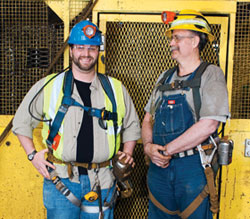Family ties run deep

Photo: Steve Babbit, Black Hills State University
Mark Hanhardt spent his childhood exploring caverns and watching his dad, who was a miner, come home from work covered in dust. Still, he had no interest in working underground. His dad, Jim, had instilled in him a love of science, and he planned instead to mine the mysteries of the stars and the universe.
But it turns out the mother lode for astrophysics lay deep underground, and not far from his South Dakota home.
Mark is now an astrophysicist working on LUX, an experiment searching for dark matter in the protective depths of the former Homestake gold mine. Jim is a shaft supervisor there. They’re one of three father-child pairs at the mine, which is home to Sanford Underground Lab and the proposed site of DUSEL, the world’s deepest underground laboratory.
When Mark was a student at the South Dakota School of Mines & Technology, his father was tearing down the lab in the Homestake mine cavern where Ray Davis had made his Nobel Prize-winning detection of neutrinos from the sun in the early 1970s.
"My dad got permission to bring me, a friend, and a professor to see it," Mark says. "That really opened my eyes to the science being done. Then DUSEL fell into place and we both ended up back here."
Now it’s Mark’s turn to teach his dad about the physics being done in the mine. Jim, in turn, fills his mining buddies in on the science, and sometimes they attend physics lectures put on by Sanford Lab.
When Mark surveyed a deep shaft for a place to put magnetometers— instruments that measure the strength and direction of magnetic fields—he turned to his dad for advice. Jim showed him places where the magnetometers would be shielded from iron in the rock, which can interfere with readings.
"I enjoy being associated with a project he’s working on," Jim says, "and it was kind of nice that he could come underground."
Tona Kunz
Click here to download the pdf version of this article.






